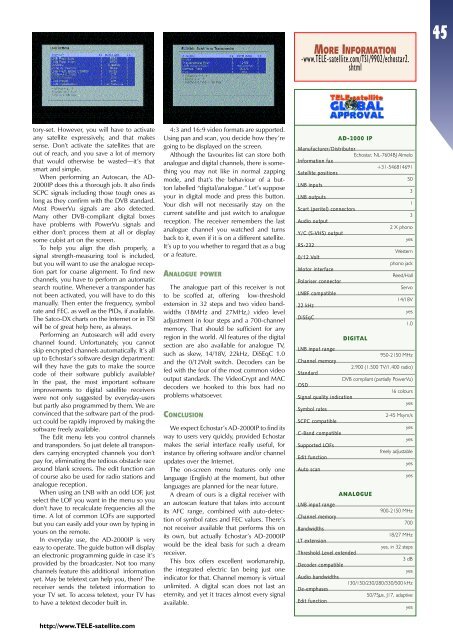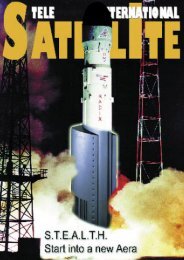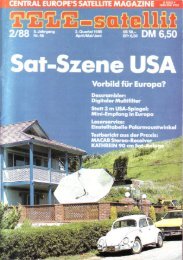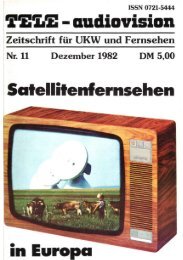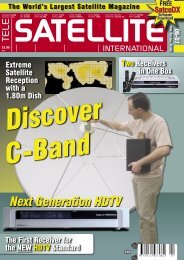Bestellen Sie diesen Satelliten- Newsletter! - TELE-satellite ...
Bestellen Sie diesen Satelliten- Newsletter! - TELE-satellite ...
Bestellen Sie diesen Satelliten- Newsletter! - TELE-satellite ...
You also want an ePaper? Increase the reach of your titles
YUMPU automatically turns print PDFs into web optimized ePapers that Google loves.
tory-set. However, you will have to activate<br />
any <strong>satellite</strong> expressively, and that makes<br />
sense. Don’t activate the <strong>satellite</strong>s that are<br />
out of reach, and you save a lot of memory<br />
that would otherwise be wasted—it’s that<br />
smart and simple.<br />
When performing an Autoscan, the AD-<br />
2000IP does this a thorough job. It also finds<br />
SCPC signals including those tough ones as<br />
long as they confirm with the DVB standard.<br />
Most PowerVu signals are also detected.<br />
Many other DVB-compliant digital boxes<br />
have problems with PowerVu signals and<br />
either don’t process them at all or display<br />
some cubist art on the screen.<br />
To help you align the dish properly, a<br />
signal strength-measuring tool is included,<br />
but you will want to use the analogue reception<br />
part for coarse alignment. To find new<br />
channels, you have to perform an automatic<br />
search routine. Whenever a transponder has<br />
not been activated, you will have to do this<br />
manually. Then enter the frequency, symbol<br />
rate and FEC. as well as the PIDs, if available.<br />
The Satco-DX charts on the Internet or in TSI<br />
will be of great help here, as always.<br />
Performing an Autosearch will add every<br />
channel found. Unfortunately, you cannot<br />
skip encrypted channels automatically. It’s all<br />
up to Echostar’s software design department:<br />
will they have the guts to make the source<br />
code of their software publicly available?<br />
In the past, the most important software<br />
improvements to digital <strong>satellite</strong> receivers<br />
were not only suggested by everyday-users<br />
but partly also programmed by them. We are<br />
convinced that the software part of the product<br />
could be rapidly improved by making the<br />
software freely available.<br />
The Edit menu lets you control channels<br />
and transponders. So just delete all transponders<br />
carrying encrypted channels you don’t<br />
pay for, eliminating the tedious obstacle race<br />
around blank screens. The edit function can<br />
of course also be used for radio stations and<br />
analogue reception.<br />
When using an LNB with an odd LOF, just<br />
select the LOF you want in the menu so you<br />
don’t have to recalculate frequencies all the<br />
time. A lot of common LOFs are supported<br />
but you can easily add your own by typing in<br />
yours on the remote.<br />
In everyday use, the AD-2000IP is very<br />
easy to operate. The guide button will display<br />
an electronic programming guide in case it’s<br />
provided by the broadcaster. Not too many<br />
channels feature this additional information<br />
yet. May be teletext can help you, then? The<br />
receiver sends the teletext information to<br />
your TV set. To access teletext, your TV has<br />
to have a teletext decoder built in.<br />
http://www.<strong>TELE</strong>-<strong>satellite</strong>.com<br />
4:3 and 16:9 video formats are supported.<br />
Using pan and scan, you decide how they’re<br />
going to be displayed on the screen.<br />
Although the favourites list can store both<br />
analogue and digital channels, there is something<br />
you may not like in normal zapping<br />
mode, and that’s the behaviour of a button<br />
labelled “digital/analogue.” Let’s suppose<br />
your in digital mode and press this button.<br />
Your dish will not necessarily stay on the<br />
current <strong>satellite</strong> and just switch to analogue<br />
reception. The receiver remembers the last<br />
analogue channel you watched and turns<br />
back to it, even if it is on a different <strong>satellite</strong>.<br />
It’s up to you whether to regard that as a bug<br />
or a feature.<br />
ANALOGUE POWER<br />
The analogue part of this receiver is not<br />
to be scoffed at, offering low-threshold<br />
extension in 32 steps and two video bandwidths<br />
(18MHz and 27MHz,) video level<br />
adjustment in four steps and a 700-channel<br />
memory. That should be sufficient for any<br />
region in the world. All features of the digital<br />
section are also available for analogue TV,<br />
such as skew, 14/18V, 22kHz, DiSEqC 1.0<br />
and the 0/12Volt switch. Decoders can be<br />
fed with the four of the most common video<br />
output standards. The VideoCrypt and MAC<br />
decoders we hooked to this box had no<br />
problems whatsoever.<br />
CONCLUSION<br />
We expect Echostar’s AD-2000IP to find its<br />
way to users very quickly, provided Echostar<br />
makes the serial interface really useful, for<br />
instance by offering software and/or channel<br />
updates over the Internet.<br />
The on-screen menu features only one<br />
language (English) at the moment, but other<br />
languages are planned for the near future.<br />
A dream of ours is a digital receiver with<br />
an autoscan feature that takes into account<br />
its AFC range, combined with auto-detection<br />
of symbol rates and FEC values. There’s<br />
not receiver available that performs this on<br />
its own, but actually Echostar’s AD-2000IP<br />
would be the ideal basis for such a dream<br />
receiver.<br />
This box offers excellent workmanship,<br />
the integrated electric fan being just one<br />
indicator for that. Channel memory is virtual<br />
unlimited. A digital scan does not last an<br />
eternity, and yet it traces almost every signal<br />
available.<br />
MORE INFORMATION<br />
-www.<strong>TELE</strong>-<strong>satellite</strong>.com/TSI/9902/echostar2.<br />
shtml<br />
AD -2000 IP<br />
Manufacturer/Distributor<br />
Echostar, NL-7604BJ Almelo<br />
Information fax<br />
+31-546814691<br />
Satellite positions<br />
50<br />
LNB inputs<br />
3<br />
LNB outputs<br />
1<br />
Scart (peritel) connectors<br />
3<br />
Audio output<br />
2 X phono<br />
Y/C (S-VHS) output<br />
yes<br />
RS-232<br />
Western<br />
0/12 Volt<br />
phono jack<br />
Motor interface<br />
Reed/Hall<br />
Polariser connector<br />
Servo<br />
LNBF compatible<br />
14/18V<br />
22 kHz<br />
yes<br />
DiSEqC<br />
1.0<br />
LNB input range<br />
Channel memory<br />
Standard<br />
OSD<br />
Signal quality indication<br />
Symbol rates<br />
SCPC compatible<br />
C-Band compatible<br />
Supported LOFs<br />
Edit function<br />
Auto scan<br />
LNB input range<br />
Channel memory<br />
Bandwidths<br />
LT extension<br />
DIGITAL<br />
950-2150 MHz<br />
2.900 (1.500 TV/1.400 radio)<br />
DVB compliant (partially PowerVu)<br />
ANALOGUE<br />
Threshold Level extended<br />
Decoder compatible<br />
Audio bandwidths<br />
De-emphases<br />
Edit function<br />
16 colours<br />
yes<br />
2-45 Msym/s<br />
yes<br />
yes<br />
freely adjustable<br />
yes<br />
yes<br />
900-2150 MHz<br />
700<br />
18/27 MHz<br />
yes, in 32 steps<br />
3 dB<br />
yes<br />
130/150/230/280/330/500 kHz<br />
50/75µs, J17, adaptive<br />
yes<br />
45


